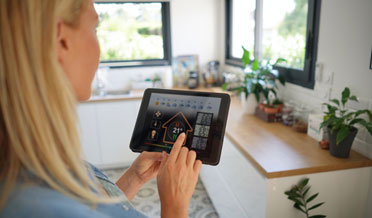8 Smart Thermostat Installation Tips
Smart Thermostat Installation
When Smart thermostats were introduced in 2007, like most new technology, they were rather clunky with lots of bugs. However, today’s models have some nice features that help homeowners save money, enjoy better home comfort, and interact with their heating, ventilation, and air conditioning (HVAC) systems. Here are some features that you can find useful on Smart thermostats, whether you have one and are not using all its features, or if you are considering a Smart Thermostat Installation in the future.
- Scheduling Options. Older programmable thermostats allowed homeowners to set a schedule of temperature settings that matched a family’s routines: reducing the winter settings at night for cooler sleeping, with 30-minute warm-up settings to begin the daily activities. Smart thermostats also come with pre-set setting options to approximate a routine without manually setting the schedule.
- Zoning Options. For homes with multiple heating and cooling systems (common with multi-story homes), the Smart thermostat works with a series of temperature sensors and in-duct dampers to customize comfort. Customized controls mean that a whole floor is not required to be kept at the same temperature. You can control the temperature of specific zones for personal preference.
- Multiple Interfaces. Smart technology goes beyond a wall-mounted control panel. And how? While you can still use the wall mount, it will have a touch screen instead of buttons or slides. You can also download the cellphone app and make changes on-the-fly. This comes in handy when your plans change, and you need to update the temperature setting. They can also be connected to virtual assistant technology for voice control.
- Motion Sensors. Smart thermostats can be set to use motion sensors. If no one is home, the heating/cooling cycles can be reduced to save energy. When the family returns and the motion sensor detect it, the temperature returns to the scheduled setting. The unique thing is the thermostat will recognize patterns of movement and develop a set schedule based on occupant movement. (Settings can also recognize cellphone proximity.)
- Energy Tracking. Smart thermostats can record your energy usage and alert you of trouble ahead. One clear sign of a failing HVAC system is a loss of efficiency, resulting in increased energy use. This observation can help you prepare for budget changes necessary for replacing the system.
- Cooling Delays. On very hot days, the demand for cooling can come too quickly. The condenser unit needs about 5 minutes to recover and prepare for the next cycle. A Smart thermostat builds in the needed recovery time to keep your air conditioner from overheating.
- Trouble Alerts. A Smart thermostat monitors the HVAC system sensors and settings. Common problems that arise with these systems place stress on electrical components. A Smart thermostat records these stress events. If a more serious event occurs—say, a circuit breaker trips—an alert is sent to your cellphone. You might not be able to reset the circuit breaker, but at least you will be prepared when you arrive.
- Maintenance Reminders. HVAC systems are complex electrical/mechanical devices that need routine maintenance. Your Smart thermostat will prompt you at three-month intervals to change the air filter or call for an annual system-wide inspection/cleaning visit.
A Smart thermostat works efficiently when programmed for your family’s preferred temperature settings and schedule. Resist the temptation to change the settings manually for momentary discomfort. Smart thermostats and Smart Thermostat Installation is reasonably priced but require a professional.
Have Questions about Smart Thermostat Installation?
For more information about R.M. Mullinix and Smart Thermostat Installation, schedule an appointment, or visit our AC Maintenance information page.

